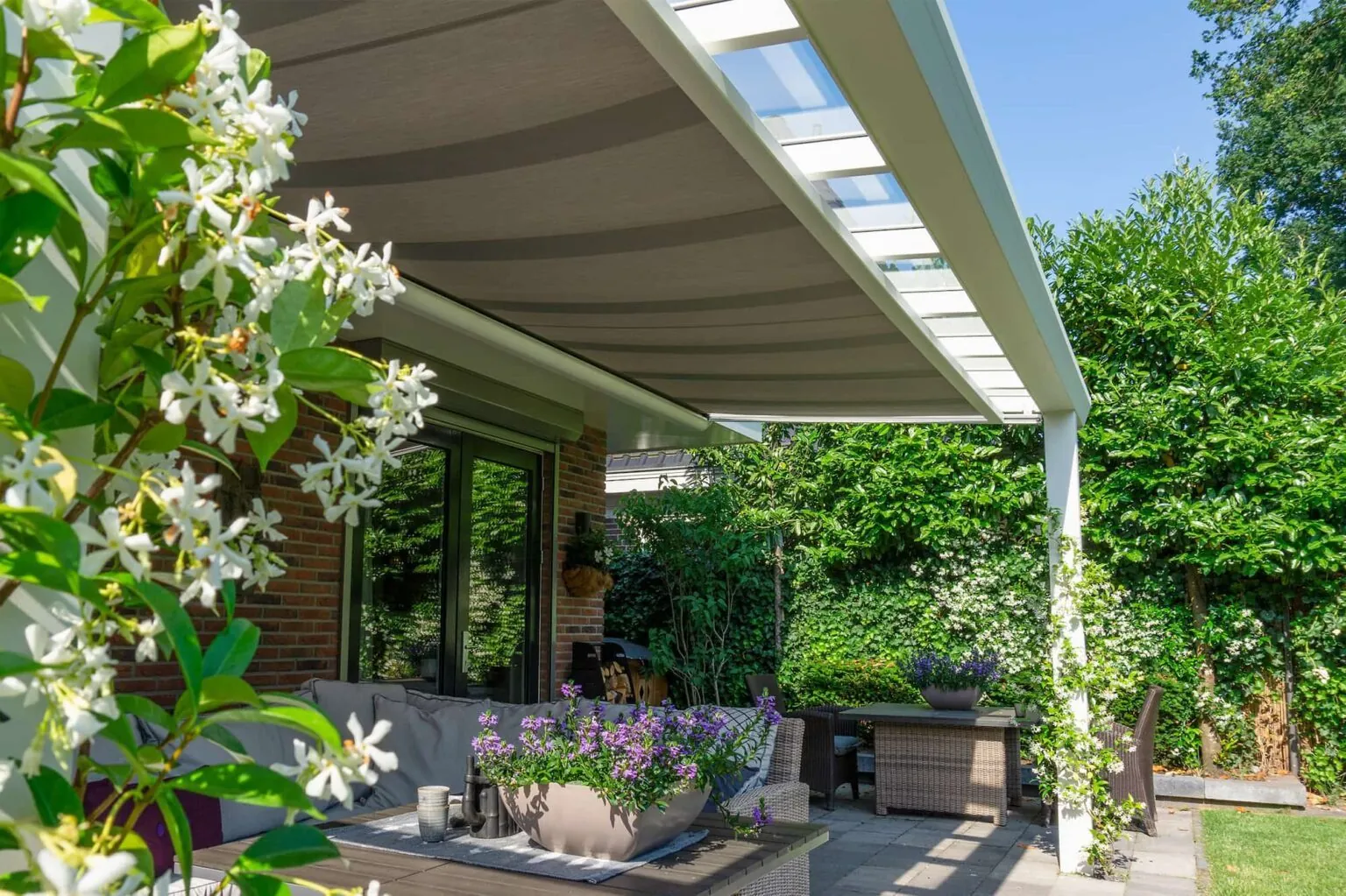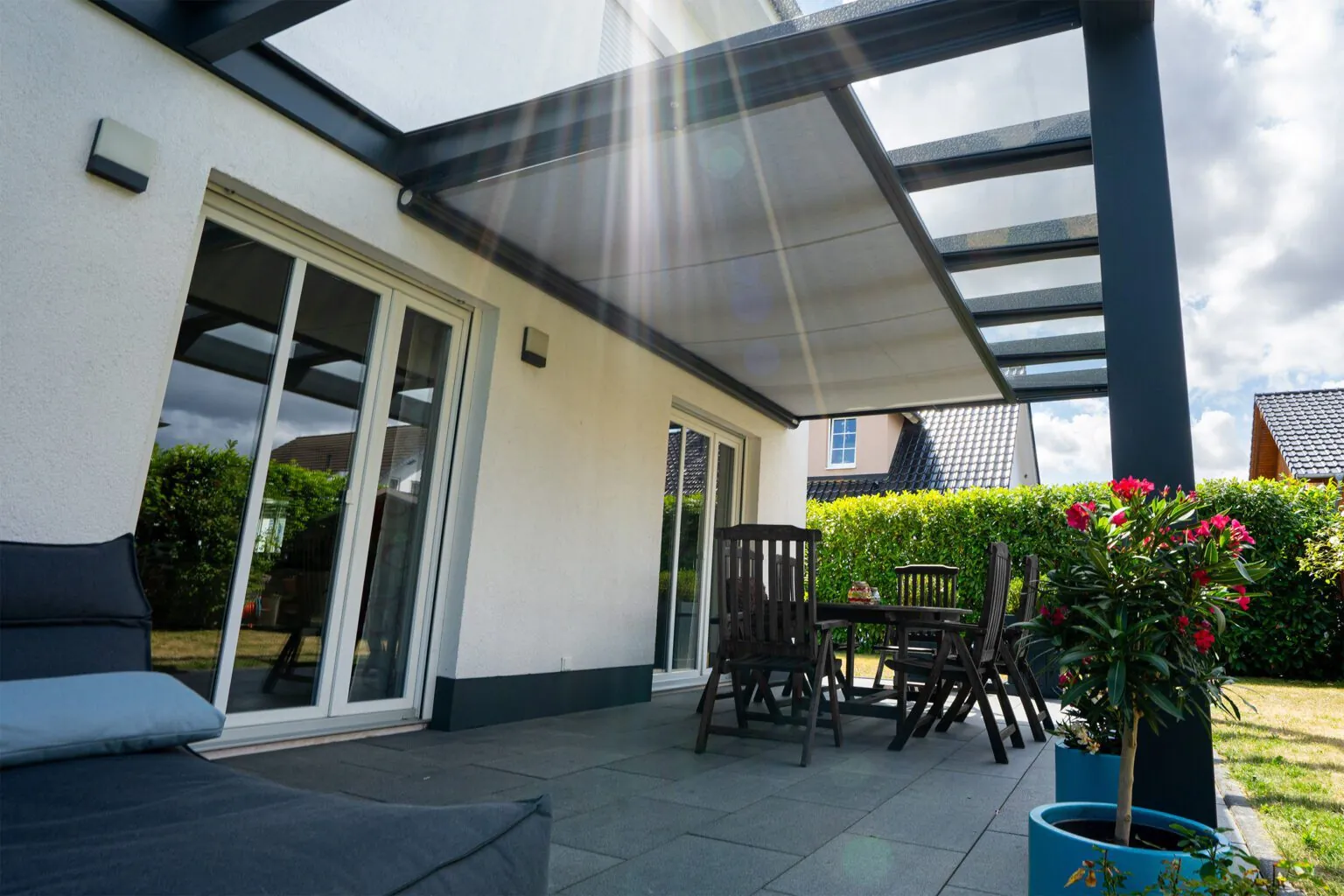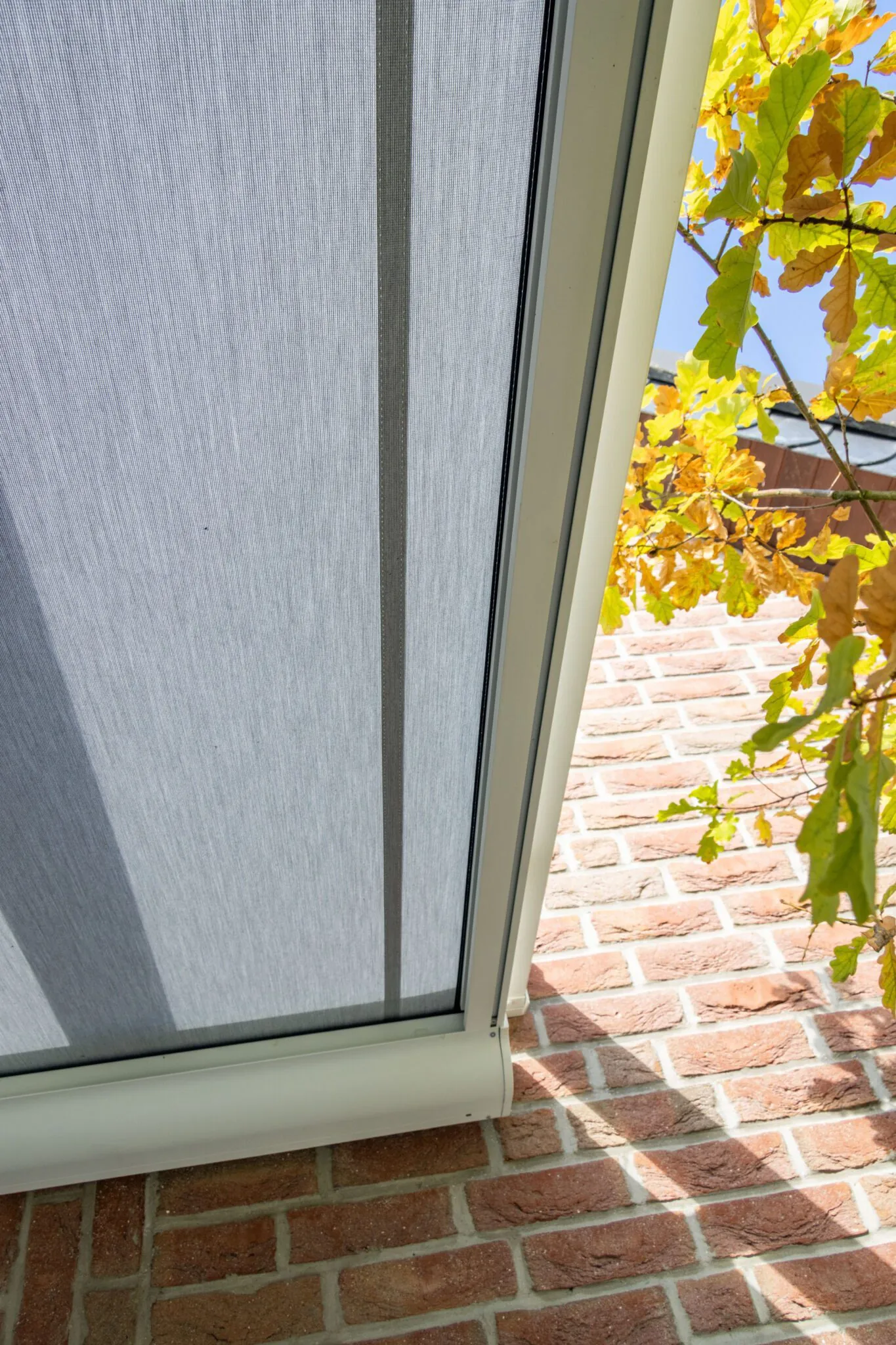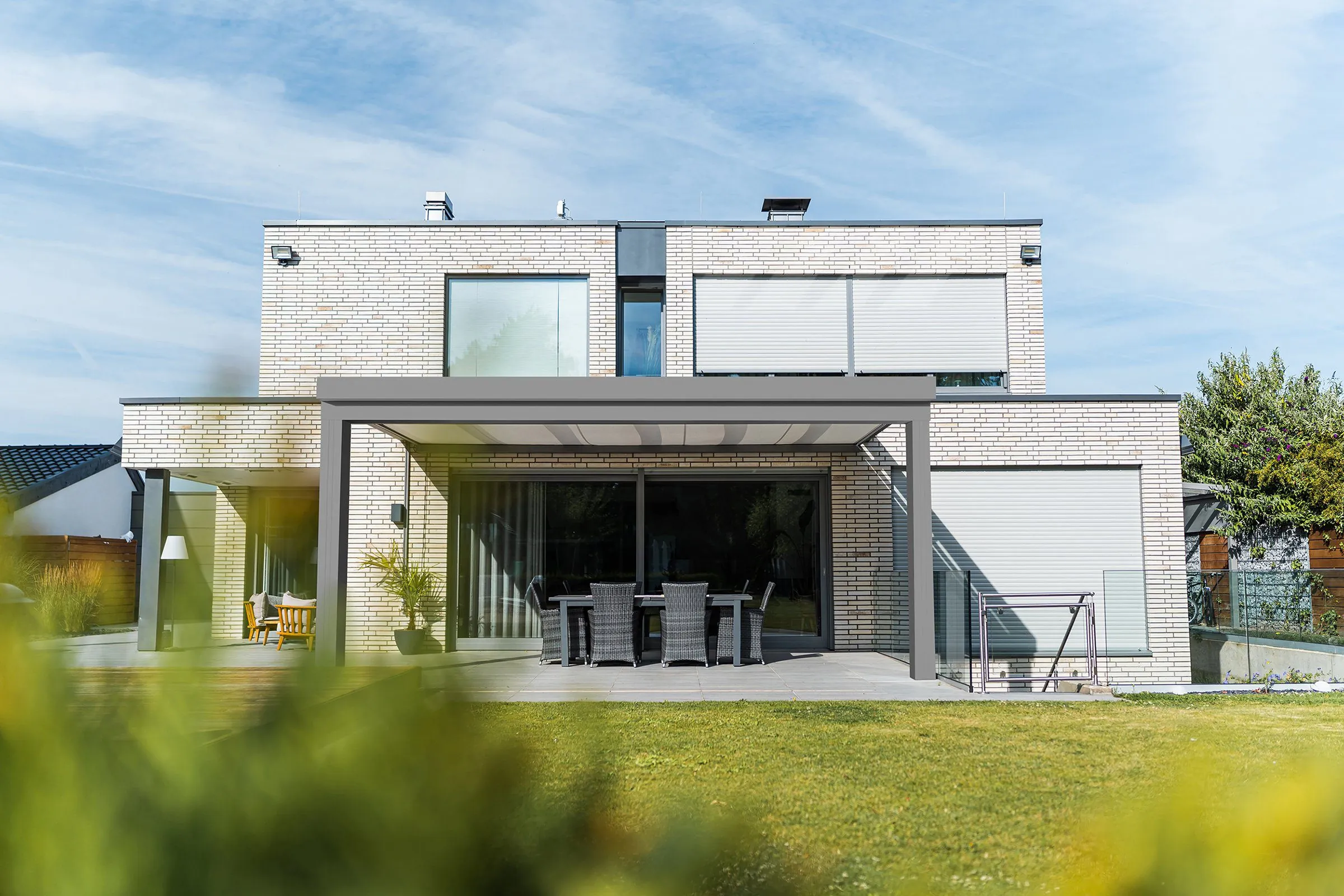Manual Roof Blinds and Under-Awnings Explained
A well-designed veranda should feel as good as it looks — a bright, comfortable space that can be enjoyed all year round. While the structure provides protection from the elements, light and temperature control determine how inviting your outdoor area truly is.
At Fleming Verandas, every system we design includes the option for integrated shading, tailored to how you plan to use your space. These solutions are designed specifically for our veranda and glass room systems — we do not offer aftermarket or retrofit blinds for existing installations, ensuring everything we fit is purpose-built, guaranteed, and perfectly matched.
Whether your veranda roof is made from polycarbonate or glass, the right shading choice makes a noticeable difference in both comfort and appearance.
Polycarbonate Roofs: Built-In Shade and Privacy
If your veranda features a polycarbonate roof, you already benefit from built-in shading and UV protection. Polycarbonate sheets are available in clear, opal, or bronze finishes, each offering a distinct level of light diffusion and solar control:
- Opal polycarbonate evenly softens natural light, reducing glare while maintaining privacy.
- Bronze polycarbonate provides a warmer tone and greater heat reduction, ideal for south-facing gardens.
Each finish blocks over 98% of harmful UV rays and diffuses light across the space, preventing the harsh hotspots associated with direct sunlight. The multiwall design also provides natural insulation — keeping the veranda cooler in summer and reducing heat loss in winter.
Because of this, there’s no benefit in fitting blinds beneath a polycarbonate roof. The material itself already performs the role of shading, and adding blinds would reduce light unnecessarily while increasing costs. Polycarbonate panels also expand slightly with temperature changes, so mechanical blinds could interfere with natural movement.
In short: for polycarbonate verandas, the roof is the shading system.

Glass Verandas: When Shading Becomes Essential
A glass veranda or glass room provides clean lines, unobstructed views, and a beautifully bright atmosphere — but that clarity also allows more heat and glare to build beneath the roof. To maintain comfort, a dedicated roof shading system is strongly recommended.
At Fleming Verandas, we offer two integrated solutions for our glass-roofed structures:
- Manual roof blinds (one per pane of glass)
- Under-awnings (full-coverage shading systems)
Both are designed to fit seamlessly within the veranda frame, installed as part of the original structure for a refined, built-in finish.
Manual Roof Blinds — One Per Pane of Glass
Manual roof blinds are a simple and effective way to control sunlight in smaller verandas or spaces that don’t require full automation. Each glass panel is fitted with its own blind, allowing light and shade to be adjusted individually as the sun moves throughout the day.
The system uses high-performance, UV-stable fabrics engineered for under-glass use. They resist fading, moisture, and stretching, ensuring smooth, reliable operation over time. The fabric range is intentionally limited, focusing on proven materials that deliver consistent results without compromising performance.
Each blind is operated by a telescopic pole and retracts neatly when not in use, preserving the sleek appearance of the roof. Because every pane moves independently, you can fine-tune comfort — shading a dining area during lunch while leaving other sections open to the sky.
Manual blinds are an excellent cost-effective option, providing targeted control and practical comfort without the complexity of automation.

Under-Awnings — Premium Full-Roof Shading
For larger glass verandas or south- and west-facing installations, an under-awning offers seamless, full-width shading beneath the roof. Installed within the veranda structure itself, the awning extends from a slimline cassette for smooth, quiet operation.
Under-awnings use specialised heat-reflective fabrics designed specifically for under-glass applications. These fabrics feature solar-control coatings that reduce radiant heat and glare by several degrees, keeping the space beneath up to 10°C cooler on bright days. Because the fabric sits below the glass, it’s completely shielded from rain, wind, and debris — significantly extending its lifespan.
Unlike manual blinds, under-awnings offer a wide variety of fabric colours, patterns, and openness levels, allowing you to choose anything from subtle neutrals to high-performance reflective coatings. This makes them the ideal choice for design-led outdoor spaces where comfort and aesthetics are equally important.
Motorised operation is standard on most systems, with optional sun and temperature sensors for automatic extension and retraction. The entire system integrates seamlessly into the veranda frame, with no visible fixings or clutter — delivering a truly premium finish.
When and How to Install Shading
The most effective shading systems are those installed at the same time as the veranda. Incorporating blinds or an under-awning during installation ensures perfect alignment with the rafters and guarantees long-term reliability.
You can add shading at any point during your veranda’s lifecycle, whether it is during the initial build stage or retrofitted later. Most of our glass roof systems are designed so that manual roof blinds and underawnings can be fitted without compromising waterproofing or the clean aesthetic.
- Fixings and seals: We mount into the aluminium rafters and support profiles, not through the glazing. Roof seals and gasket lines remain intact.
- Cable routing (underawnings): Discreet routes are available via rafters or posts, surface wiring is avoided wherever possible.
- Survey first: One element of the site survey is dedicated to shading options, and the CAD drawing will confirm all geometry, load paths, and cable routes so the retrofit looks and performs like it was installed from the very beginning.
- Lead times: Retrofit shading can be a quick install, with minimal disruption to your aesthetic
As part of our consultation service, we can also provide virtual renders, allowing you to visualise how different shading configurations, fabric colours, and light levels will look before installation.

Maintenance and Longevity
Both manual blinds and under-awnings are designed for minimal maintenance. Occasional dusting or gentle vacuuming of the fabric is usually all that’s needed. Under-awnings, protected beneath the glass, remain cleaner for longer and require no weatherproofing treatments. With correct use and care, these systems can perform reliably for well over a decade.
Choosing the Right Shading System
When selecting the right solution, we’ll assess the orientation, glazing type, and how you plan to use the space:
- Polycarbonate roofs: Already shaded — no blinds required.
- Glass verandas: Manual blinds for flexible, individual control; under-awnings for complete, even coverage.
- Enclosed spaces: Combine roof shading with vertical zip blinds or side screens for added comfort and privacy.
You can learn more about our glass veranda designs and glass rooms to explore which configuration best suits your home by looking at our product range and our YouTube channel.
Designed to Perform, Built to Last
At Fleming Verandas, we don’t treat shading as an afterthought — it’s part of the overall design philosophy that makes our systems elegant, durable, and usable all year round.
As proud members of the Guild of Master Craftsmen and Which? Trusted Traders, we combine technical expertise with design-led installation and reliable aftercare.
Whether you’re enjoying a quiet morning coffee or hosting summer evenings outdoors, the right shading turns your veranda into a genuine extension of your home — comfortable, stylish, and made to last.
To explore shading options for your new veranda or glass room, contact Fleming Verandas today for expert advice and a free design consultation. Our telephone number is 01902 212 331, and our email address is [email protected].
Got questions? Here are some of our most common!
Do I need blinds on a polycarbonate veranda roof?
No — polycarbonate roofs already diffuse light and block UV rays effectively, especially in opal or bronze finishes. These materials provide natural shade and privacy without additional blinds. Adding blinds to a polycarbonate roof would reduce light unnecessarily and offer little benefit.
Can I add shading to my existing veranda?
Yes — both manual roof blinds and under-awnings can be retrofitted to most Fleming Verandas glass roof systems. The installation process is quick, clean and does not compromise the waterproofing or appearance of the structure. A short site survey allows us to confirm compatibility and fitting options.
What’s the difference between manual roof blinds and an under-awning?
Manual blinds are fitted per pane of glass, offering individual light control and cost-effective shading for smaller verandas.
Under-awnings, by contrast, extend across the entire roof to provide uniform shading and are often motorised. They use higher-performance fabrics and are ideal for larger, south- or west-facing installations.
Can shading be automated?
Yes — under-awning systems can be fitted with motorised controls, remote operation, and optional sun and temperature sensors. These automatically extend or retract the awning based on light or heat levels, ensuring consistent comfort without manual adjustment.
Do the blinds or awnings need regular maintenance?
Both systems are low-maintenance. Manual blinds benefit from occasional dusting or light vacuuming, while under-awnings—being protected beneath the roof—stay cleaner for longer. Neither requires weatherproofing or complex servicing.
Are there different fabric options available?
Yes — but the choice varies by system.
Manual roof blinds have a limited selection of proven fabrics, chosen for durability and reliability.
Under-awnings offer a far wider range of colours, textures and performance coatings, including reflective and heat-reducing options for design flexibility.
Will roof shading make my veranda dark?
No — both systems are designed to filter sunlight, not block it completely. The fabrics are semi-translucent, maintaining a pleasant level of natural light beneath the roof while reducing glare and heat.
Can I see how the shading will look before installation?
Absolutely. As part of our service, we can provide virtual renders showing how different shading configurations and fabric colours will look within your veranda or glass room. This helps you visualise the end result before work begins.
Does roof shading affect the warranty?
When installed by Fleming Verandas, all roof shading systems are fully compatible and covered under warranty alongside your structure. Retrofitted systems added later by our team receive their own manufacturer-backed warranty.




